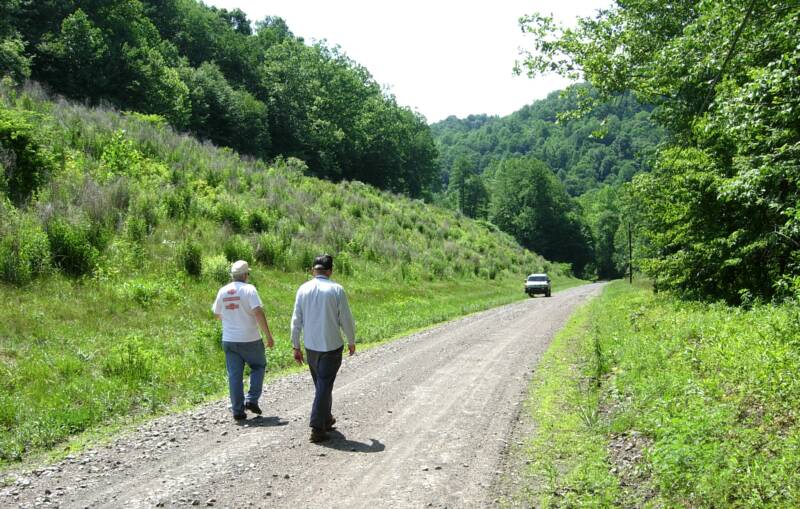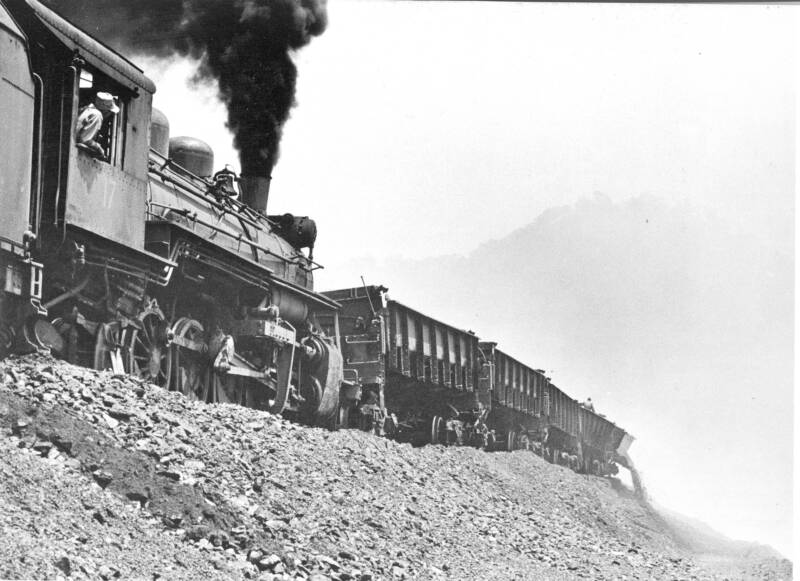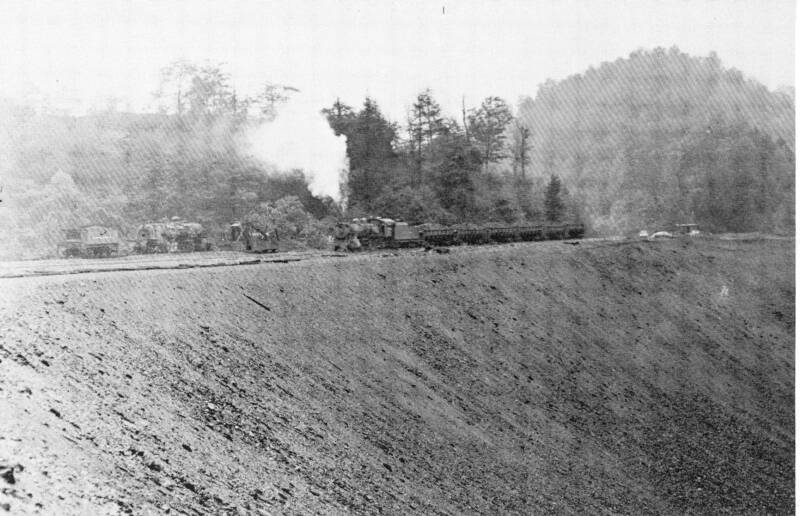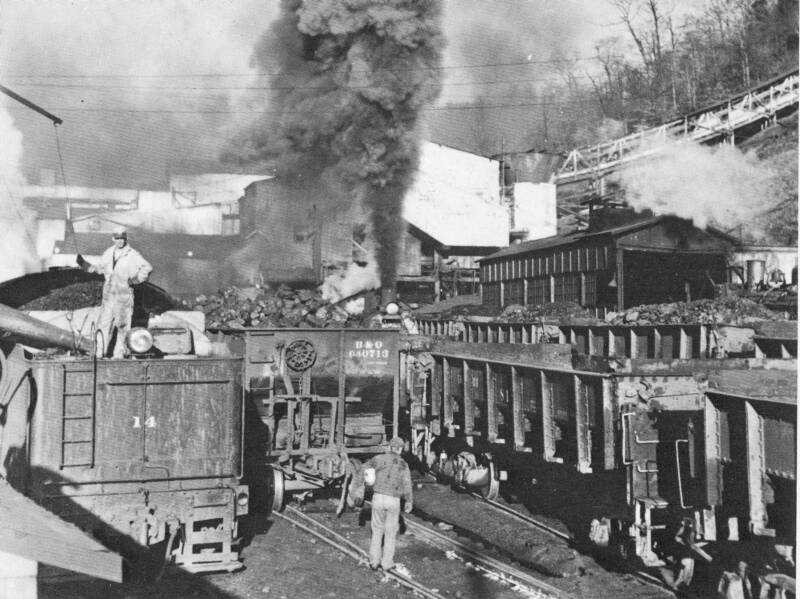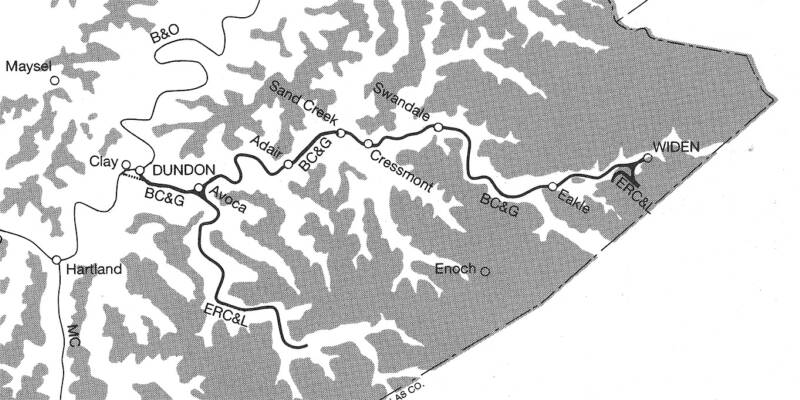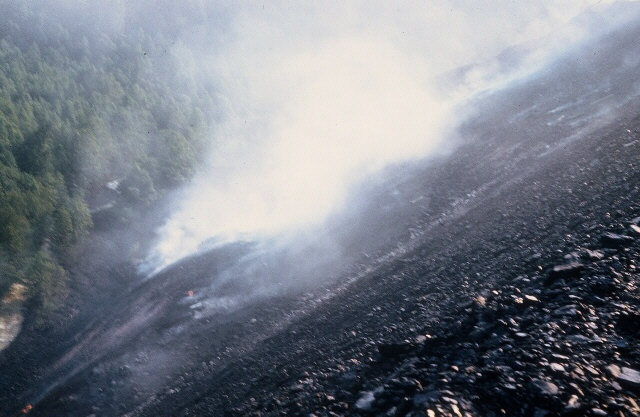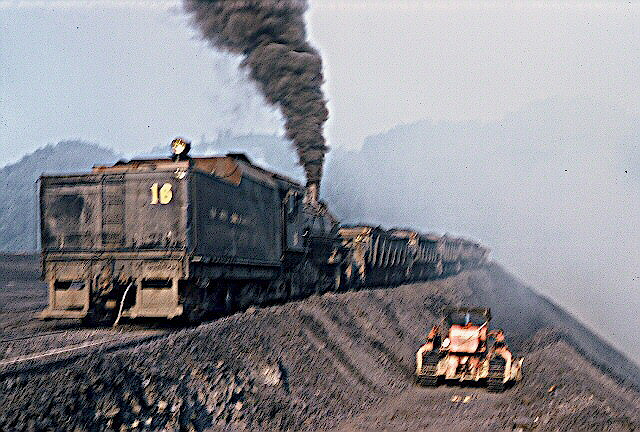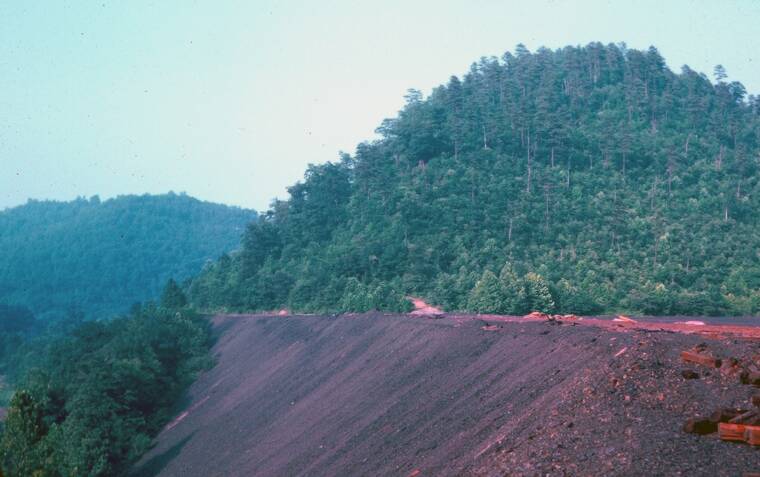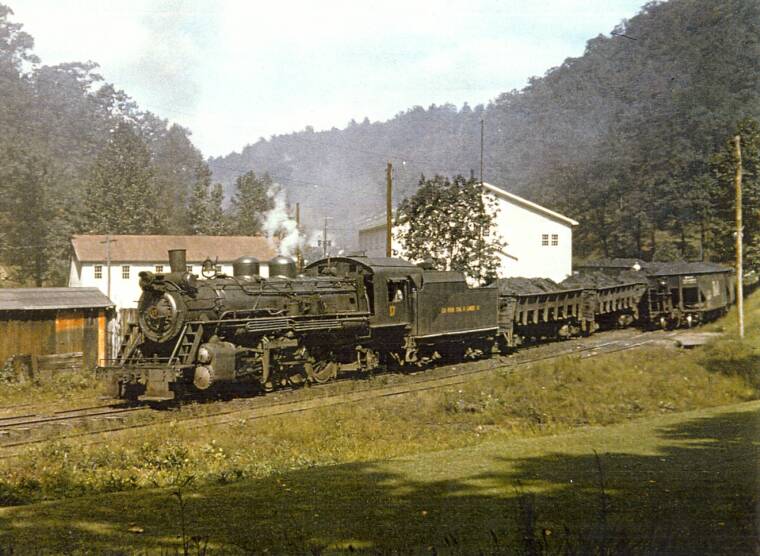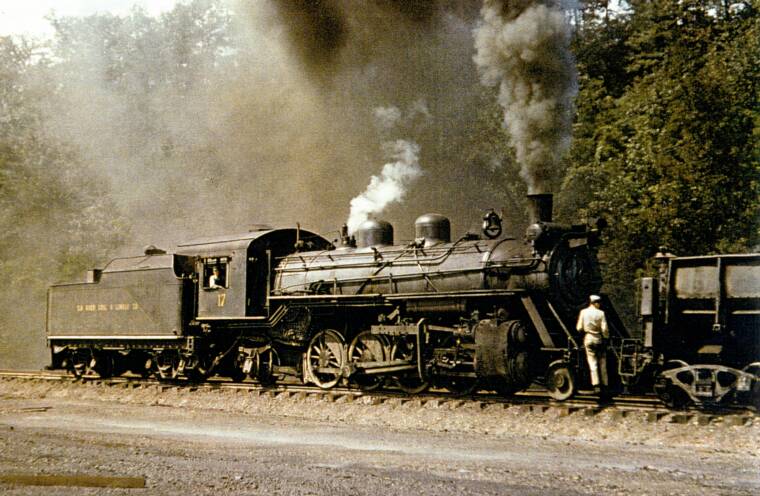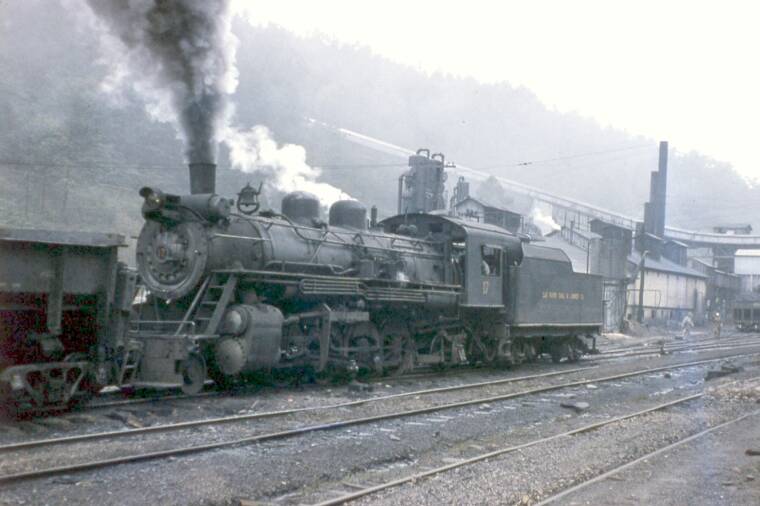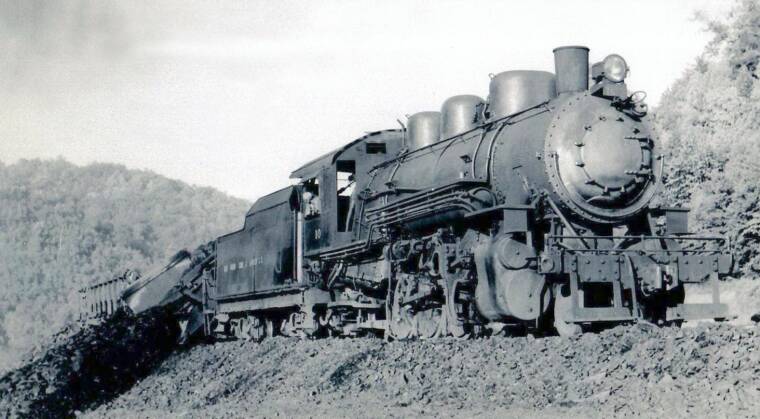ERC&L Gob Operations
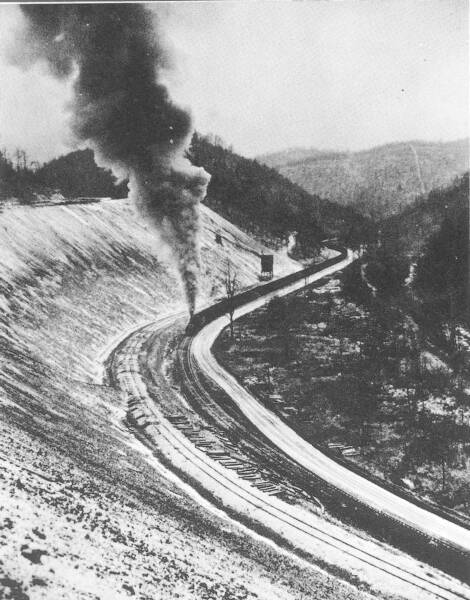
Besides the more well-known logging activity, the Elk River Coal & Lumber Company also operated a small fleet of Mikados that had a singular purpose, namely hauling short trains of Clark side-dump gondolas loaded with mine waste, commonly called "gob", from the Rich Run tipple to the giant gob pile east of Widen. The images on this page are from the Warden BC&G book. I have searched for others showing this operation but have found none. For photos of my 'S' scale model of one of the Clark cars, click here.
Here's what the tracks at the tipple looked like...a mixture of engines, coal hoppers and gob gondolas. The fleet of gob gondolas numbered upwards of 35 cars.
The photo above shows one of the Mikados on the switchback that led to the gob pile. The switchback is shown on the map from the back inside cover of the Warden book.
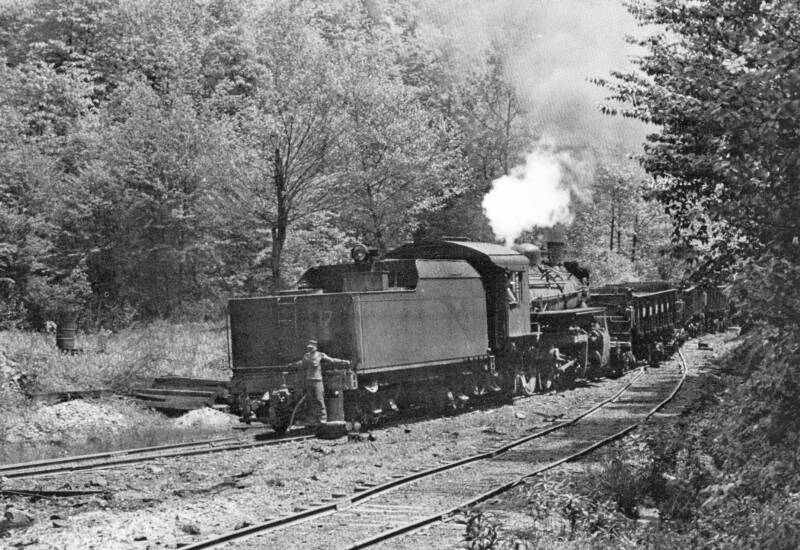
Switchback
The photo above shows the enormous gob pile west of Widen. The train on the curve is on the BC&G main heading to Widen, just a mile or so ahead. Just visible on top of the gob plile is a train of Clark gondolas. Above right is one of the few photos of the Clark cars in dumping position.
December 17, 1963 by Jack Emerick
1961 - Richard Manning Collection
Engine #15 is visible derelict on the gob pile in this March 1957 photo by Phil Ronfor, from page 73 of the Warden BC&G book. The engine was finally cut up in 1961.
David G. Knox photo - May 1959
This photo shows how the foot of the gob pile appears in 2007, after reclaimation efforts. From the best of my ability to discern, the photo was taken from about the location of the BC&G engine in the Emerick photo. The BC&G track is buried under the earth that was brought in to cover the gob. It emerges from under the earth a ways beyond where the road curves out of view in the distance.
Brooks Stover photo, June 2007
This photo from Theodore Griffith was taken during the winter of 1957-58. The location of this mishap was just behind the WIden Bank. I'd guess it took a while to get #17 back on the rails! Is the guy with his hand on the locomotive the only thing keeping it from going all the way over?!
Theodore Griffith photo - WInter 1957-58.
The three color photos here were taken by Mr. Roland Coluzzi, Sr. and were provided by Roland Coluzzi, Jr. Roland Jr's. mother was born and raised in Widen. Roland, Jr. grandfather worked in the Rich Run Mine. Roland, Jr. spent many summer days in and around Widen. These are rare color pictures of the gob train in action and the actual smoldering gob.
The Gob Pile by Roland Coluzzi, Jr.
"The gob pile had a smell that I found very exciting. It let me know that the trains were rolling and the miners working. Although some Wideners will tell you my Grandpa John Potasnick set it on fire when he caught the hillside on fire burning trash...we know better...spontaneous combustion. The main gob pile down towards Taylor had a couple of sisters right in Widen. The gob pile up the holler on Roane Street burned worse that the gates of hell and it smelled even worse than it burned. I was very disappointed on day in the 1970s when I visited and saw that they had put out the fires and were able to even plant some grass."
"The ponds at the bottom of the gob piles were referred to as 'gook ponds'. Kind of catchy...'gob piles and gook ponds'! Sounds like a book title! There were three tiered large mine-waste sediment ponds almost behind Mannings old house up the hill. If the gob was the fires of hell, these ponds looked like something the gob ate for breakfast!
GOB OPERATIONS - by Ovalee Gil
According to Ovalee Gill, a crewman on the ERC&L gob trains, there were two gob piles. The one most familiar is the larger pile to the west of the tipple. It is believed that all the pictures on this page are of this pile. There was, however, an upper gob pile on the east side of the tipple. The upper pile was started sometime in the mid-1940s. Photos of the upper gob pile are at the bottom of this page. Both piles remained in use and were served by rail up until 1959. After that, Euclid trucks hauled the gob to the upper pile and rail service to the lower pile stopped.
Each train that went to the gob pile below Widen was made up of six (6) Clark cars. Only three (3) cars were used on trains to the gob pile above the tipple. There were three crewman on each train: engineer, fireman and brakeman. As there were no cabooses on the gob trains, the brakeman rode in the locomotive cab.
As noted in the section on ERC&L locomotives, most of the gob engines were second-hand Mikados. While seemingly large for the task, the grades on the lines to the gob piles were steep, according to Ovalee.
Again according to Ovalee, gob trains departed the tipple about every hour, or as fast as they returned from the gob pile. Assuming a six car train headed out every hour, 45-50 cars of gob were loaded in an 8-hour shift. On the west pile, both the wye and the switchback (see map above) were used to get the train in the desired configuration for going out on the gob pile and returning to the tipple.
There were telephone boxes at Widen and at the wye that were used by crews to coordinate movements of gob trains with the BC&G coal trains. All the maintenance of the gob engines was done at the engine facility near the tipple in Widen.
Many thanks to Lois Kincaid, Ovalee's daughter, for getting this information from her dad and thanks to Ovalee for sharing his memories!
John Phillips 10-2-58
The Gob Pile
Here are three nice color photos of the gob trains in action. The photo on the left by John Phillips shows ERC&L #17 pushing on a Clark gob car on a hazy day.
In the two undated photos below by an unknown photography shows the same engine on what appears to be a clearer day. Below left the engine is leaving with the cars in tow. Presumably the photo below right is near the wye after the engine has run around the cars in preparation for pushing the string out onto the gob pile.
Wye
This wonderful photo was provided by Roger Johnson. It is unique in a couple of ways. First, it clearly shows a Clark car in the dump position, perhaps the best photo of this that has surfaced to date. Second, it is a beautiful view of engine #10, the Mikado of which we seem to have the fewest in-service photos.
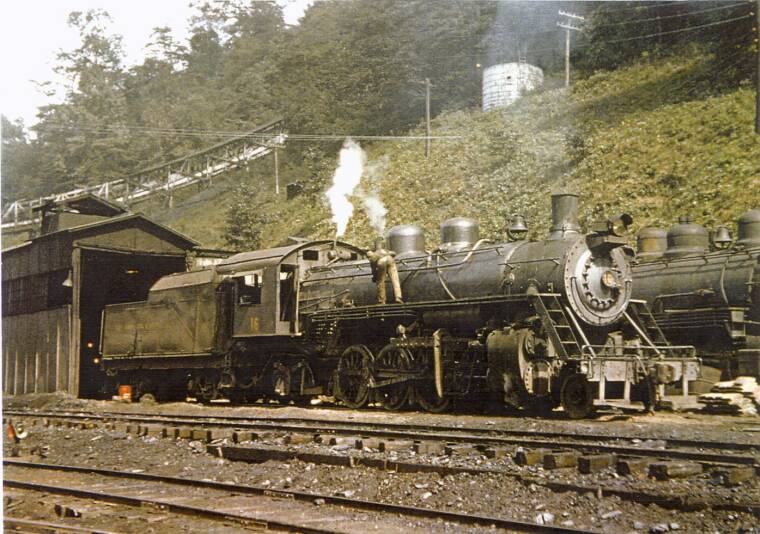
According to Ovalee Gill, the maintenance of the gob engines was done at Widen. This undated photo by an unknown photographer shows some work being done on #16.
The old conveyor is visible in the background as is a hillside tank, a nice detail to model.
